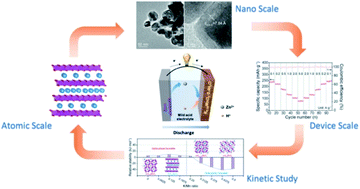Enabling stable MnO2 matrix for aqueous zinc-ion battery cathodes†
Abstract
The primary issue faced by MnO2 cathode materials for aqueous Zn-ion batteries (AZIBs) is the occurrence of structural transformations during cycling, resulting in unstable capacity output. Pre-intercalating closely bonded ions into the MnO2 structures has been demonstrated as an effective approach to combat this. However, mechanisms of the pre-intercalation remain unclear. Herein, two distinct δ-MnO2 (K0.28MnO2·0.1H2O and K0.21MnO2·0.1H2O) are prepared with varying amounts of pre-intercalated K+ and applied as cathodes for AZIBs. The as-prepared K0.28MnO2·0.1H2O cathodes exhibit relatively high specific capacity (300 mA h g−1 at 100 mA g−1), satisfactory rate performance (35% capacity recovery at 5 A g−1) and competent cyclability (ca. 95% capacity retention after 1000 cycles at 2 A g−1), while inferior cyclability and rate performance are observed in K0.21MnO2·0.1H2O. A stable δ-MnO2 phase is observed upon cycling, with the reversible deposition of Zn4SO4(OH)6·5H2O (ZSH), ion migration between electrodes and synchronous transition of Mn valence states. This work firstly and systematically reveals the role of the pre-intercalated ions via density functional theory simulations and show that above a threshold K/Mn ratio of ca. 0.26, the K ions suppress structural transformations by stabilizing the δ phase. To demonstrate its commercial potential, AZIBs with high-loading active materials are fabricated, which deliver adequate energy and power densities compared with most commercial devices.

- This article is part of the themed collection: Journal of Materials Chemistry A HOT Papers


 Please wait while we load your content...
Please wait while we load your content...